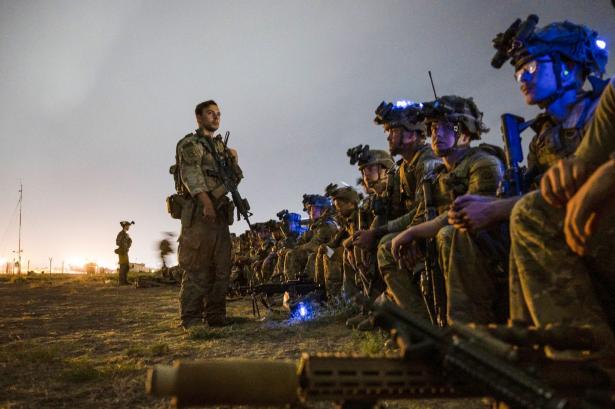That figure includes the costs of veterans’ care through 2050, which is trillions higher than researchers previously estimated. Earlier estimates for the cost of all post-Sept. 11 wars had been about $6.4 trillion.
The project’s researchers also estimated that the wars have directly killed an estimated 897,000 to 929,000 people, which is considered a “conservative estimate.”
The Costs of War project, which launched in 2010 and is housed at Brown’s Watson Institute for International and Public Affairs, released updates Wednesday to its comprehensive data on the budgetary and true human costs of wars after the Sept. 11, 2001, attacks that killed nearly 3,000 people in New York, rural Pennsylvania, and Washington, D.C.
Researchers for the project reported direct war costs, which include all Department of Defense Overseas Contingency operations funding and State Department war expenditures, and counterterror war-related costs such as increases to the Pentagon’s base budget, care for veterans to date and in the future, spending by the Department of Homeland Security, and interest payments on borrowing for these wars.
Of the approximately $8 trillion estimated cost of the wars, $2.3 trillion can be attributed to the war zones in Afghanistan and Pakistan, $2.1 trillion to the war zones in Iraq and Syria, and $355 billion was attributed to other war zones.
The total also includes $1.1 trillion of related spending by Homeland Security and an estimated $2.2 trillion earmarked for future veterans’ care, including future medical care and disability payments, over the next decades.
These estimates do not include all the money provided for humanitarian assistance and economic development aid in Afghanistan and Iraq, nor the future costs of interest payments on borrowing to pay for the wars after fiscal year 2023, nor spending by state or local governments for counterterrorism or services for post-Sept. 11 war veterans. It also does not include spending by the dozens of US allies, such as Australia, Britain, Canada, Denmark, Italy, the Netherlands, Romania, Germany, and France.
According to the report, which was written by Boston University political science professor and chair Neta C. Crawford, who is also co-director of the Costs of War project, the US would have likely had to spend more on those wars if it had not been for the support of those allies.
“There has been no single US government estimate for the total costs of the post-9/11 wars. There are partial accounts of post-9/11 war costs,” wrote Crawford.
In March, the Defense Department released its most recent estimate that emergency and overseas contingency operations spending for wars in Iraq, Syria, and Afghanistan cost a total of $1.6 trillion, or $8,094 per taypayer through fiscal year 2020. But those amounts entirely exclude non-Defense Department classified programs.
The lack of clear expenses from the federal government is why the Costs of War project was launched, wrote Crawford.
“Democracy can sometimes take a beating during war. Operations may be shrouded in well-intentioned but perhaps unnecessary secrecy, and mistakes are generally swept under the rug or downplayed,” read the report. “The Costs of War Project hopes that this accounting, and our other work, promotes transparency and facilitates informed conversations about current and future wars.”
What were some of the other costs?
- The Pentagon’s “base” budget increased by $884 billion, which means that it has more than doubled between fiscal years 2001 and 2022, even as spending on the post-Sept. 11 wars and other military operations declined. The “base” budget is intended to fund enduring costs of the defense department and armed services even if the US was not at war. It includes costs of personnel, including health care, the costs of research and development, procurements, operations, military construction and housing, and equipment maintenance.
- Military pay increased 6.9 percent in 2002, which was the largest percentage increase since the early 1980s. Between 2002 and 2018, regular military compensation (cash, allowances for food and housing, and tax advantages) grew by 20 percent just for the active duty force. And when casualties during the wars were high, enlistment rates took a hit, so the military used bonuses to increase enlistment.
- The Defense Health Program budget more than doubled, from $13.5 billion in fiscal year 2001 to $34.1 billion in fiscal year 2021.
- It’s difficult to track spending on the counterterrorism mission for homeland security. But data show that from fiscal year 2003 through fiscal year 2017, the entire US government directed roughly $878 billion to three mission sets under the Department of Homeland Security, including “preventing and disrupting terrorist attacks”; “protecting the American people, critical infrastructure, and key resources”; and “responding to and recovering from incidents.”
What was the human toll of the wars?
- At least 387,072 civilians died due to direct war violence. This does not include the nearly 301,933 opposition fighters killed. Others include about 680 journalists and 892 humanitarian aid workers who were killed as a direct result of war.
- Approximately 7,052 members of the US military were killed as a direct impact from the post-Sept. 11 wars. That does not include the 8,189 US contractors, 21 defense department civilian workers, or the 204,645 to 207,845 national military or police killed.
- All together, about 929,000 people were killed from the post-Sept. 11 wars, which is an increase from previous estimates of 801,000.
[Alexa Gagosz can be reached at alexa.gagosz@globe.com. Follow her on Twitter @alexagagosz.]


Spread the word